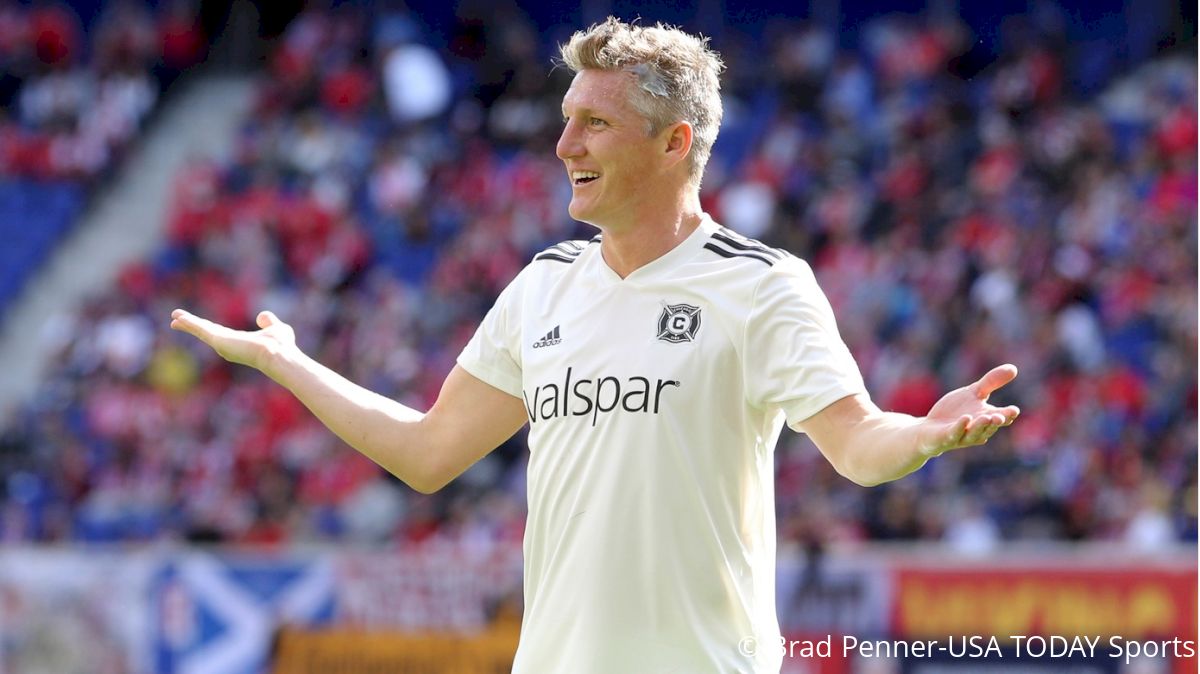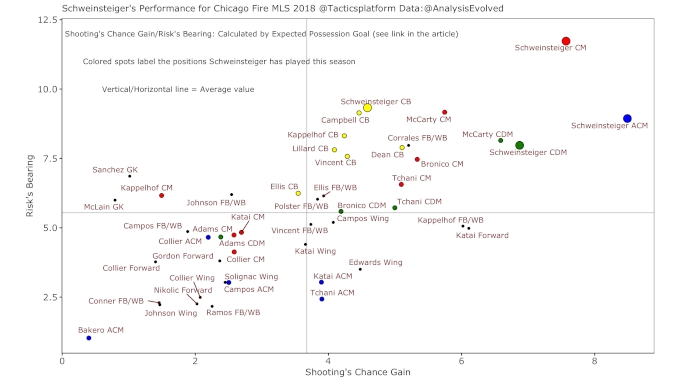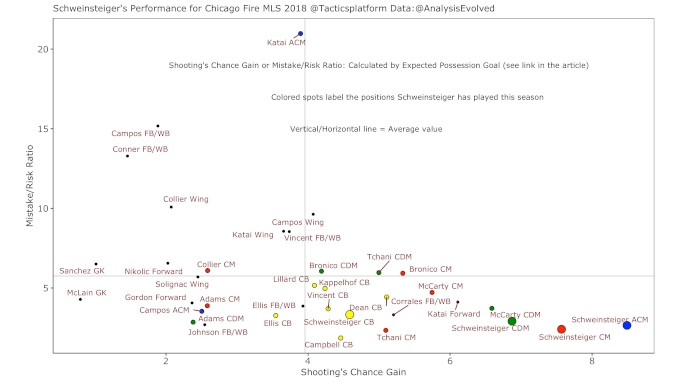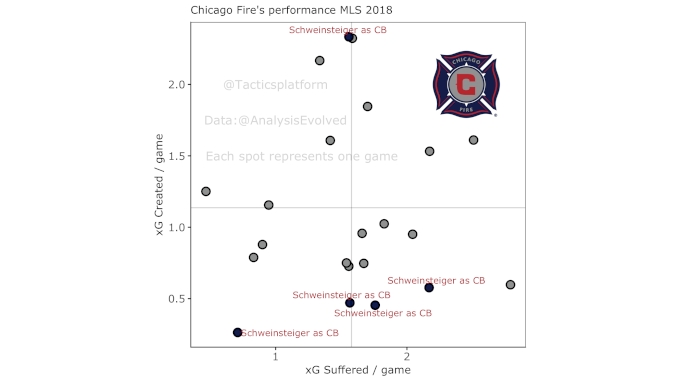How Can The Chicago Fire Most Efficiently Deploy Bastian Schweinsteiger?
How Can The Chicago Fire Most Efficiently Deploy Bastian Schweinsteiger?
Bastian Schweinsteiger has played a number of positions for the Chicago Fire, but where does he fit best?

Bastian Schweinsteiger is a legendary midfielder.
He succeeded after other great German predecessors like Franz Beckenbauer, Lothar Matthaus, and Matthias Sammer. He was one of the best playmakers in the world in his prime. The upcoming friendly game on August 28 between his current club, the Chicago Fire, and his former club, FC Bayern Munich, pays tribute to his fantastic career — and you can catch the game right here on FloLive.
The Fire have endured a disappointing season — they sit toward the bottom of the Eastern Conference — and they have shifted Schweinsteiger around to deal with some of the adversity they've faced, including a number of key injuries at inopportune times. Manager Veljko Paunovic has therefore used Schweinsteiger all over the field — on a back line of three, in the absolute middle of the park, and as an attacking midfielder. The experimentation in the latter part of Basti's career is interesting, so we decided to take a data-driven approach to see where he fits best for Chicago.
Schweinsteiger As The Perfect Playmaker
Schweinsteiger's fantastic technique allows him to protect the ball from the opponent’s pressure. He also has an excellent passing range with which he can regularly make a penetrative pass to open up the opponent’s defense. This skill set means Schweinsteiger should carry the load of initiating the transition into the offensive phase. He has to be Chicago Fire’s playmaker.
Here’s a comparison of all the central midfielders in MLS using their playing style and efficiency:
Schweinsteiger is most similar to Benny Feilhaber (Los Angeles FC) and Michael Bradley (Toronto FC). They belong to a group of midfielders that relies on excellent passing range to organize their teams. Their biggest weapon is the use of vertical through passes to split the defense and create chances. Schweinsteiger makes 0.2 such passes per game, seventh-most in the league and almost three times more than the league average. Bradley and Feilhaber are the default playmakers for their teams; Schweinsteiger should play the same way for the Fire.
Like Bradley and Feilhaber, Schweinsteiger at this stage can’t anchor the midfield’s defense by personal defensive strength alone. He was never a midfield destroyer like N'Golo Kante (Chelsea) or Casemiro (Real Madrid) even in his prime. As he ages, his physical strength and athletic ability also wane. Father time has caught up. All of his defensive action attempts except tackle is below average compared to other qualified midfielders in MLS. Schweinsteiger should focus on dictating the play but not carrying the defensive load.
For the Fire to transition into the offensive phase, Schweinsteiger often combines with Dax McCarty. Chicago’s passing game can’t function without them: each of them makes more than 66 passes per game, almost two times more than the team’s average (34 passes per game).
The interaction between them is critical for Chicago:

This season, they have made over 300 passes between each other, at least 10 percent more than any other combination. Both players are excellent passers; Schweinsteiger and McCarty make over 85 percent of the passes per game, the second- and third-highest of the team. Their combination is critical for the Fire to evade the opponent’s pressure and move the ball out of the defense to attack.
They are so important for Chicago’s transition because they often initiate the attack in the most vulnerable area. Losing the ball there would be disastrous. We can measure how much contribution a player makes to increase his team’s chance to shoot and how much risk a player bears for his team by Expected Possession Goal (xPG, click here and here for a detailed explanation).


No matter what positions they play at, Schweinsteiger and McCarty are Chicago’s most essential players in balancing the risk and reward. Schweinsteiger as the midfielder has the most significant contribution to increase Chicago’s chance to shoot and score. He also bears the most risk in most positions he plays at. Better, he makes few mistakes; for all the regular starters, only Jonathan Campbell has been more careful with the ball than Schweinsteiger. Chicago can’t function without him.
Schweinsteiger As The Libero
The Fire have used Schweinsteiger as the libero, the roaming and creative center, in their starting lineup at least five times this season. Beckenbauer, Matthaus, and Sammer all played that role in the later stage of their career. Schweinsteiger never got this chance in Europe. In Chicago he has that chance; the Fire has a big problem in moving the ball out of the defense under pressure. They need Schweinsteiger to become their libero. Everyone likes this tactic, but does it work?

Let’s first ask whether Schweinsteiger has done well in advancing the ball from the defenders when he is under intensive defensive pressure. Here I measured how a center back performs in a pressurized situation where he has to make a pass within two seconds after receiving the ball in the defensive third. The x-axis measures how accurate he passes in this situation while the y-axis measures how much shooting probability gain his passes can achieve.
Compared to other center backs in the league (grey spots), Brandon Vincent is surprisingly good in striking a balance between accuracy and offensive prowess in his passes under pressure. Schweinsteiger makes the most aggressive passes as the center back for Chicago with lower accuracy. For the other Chicago center backs, their passes are wildly imbalanced: Campbell plays too safe while Johan Kappelhof and Grant Lillard gamble too much. These data support the Fire’s decision to put Schweinsteiger as the center back so that he can help transition from the defensive phase to the offensive phase.
But there are many problems. First, Schweinsteiger isn’t a great defender. He isn’t a midfield destroyer, and you can’t expect him to excel as a center back in which he has to spend most of his time marking and whistling with the opponent’s attackers.
Worse, Chicago’s performance doesn’t support putting Schweinsteiger in the defense:

For all five games that the Fire have used Schweinsteiger as a center back, they have only managed to create better chances than their season average (measured by Expected Goal/xG created) on one occasion (against Toronto FC). That game is likely an outlier. In fact, in the other four games, they record the fewest xGs this season. Their defense doesn’t look promising, either. So although Schweinsteiger’s attribute may appear to be a good fit for the Fire to play out from the back, it hurts their chance creation.
The Fire play a 3-5-2 when they use Schweinsteiger as the center back. The two-sided center backs lack offensive ability to help to create chances. In a back four, they could not efficiently pass the ball out from the back. The back three with Schweinsteiger solves this problem. But once the ball reaches the midfield, the Fire struggle attacking. Effectively they are moving the ball progression problem from the defense to the midfield.
So after all, there may not be any reason for Chicago to play Schweinsteiger as the libero. The tactic doesn’t make sense in Europe. The data don’t support it in MLS. The Fire need to put him back in the midfield. We need to watch the legend play in his best position before he finally calls it a day.
Don't forget to catch Basti play with and against his old team, right here on FloLive.
All the data are provided by American Soccer Analysis.
Cheuk He Ho is a scientist during the day who writes about MLS and Serie A during the night. You can find his work at tacticsplatform.com and on Twitter at @Tacticsplatform.